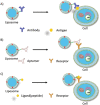Multi-Functional Liposome: A Powerful Theranostic Nano-Platform Enhancing Photodynamic Therapy
- PMID: 34085415
- PMCID: PMC8373168
- DOI: 10.1002/advs.202100876
Multi-Functional Liposome: A Powerful Theranostic Nano-Platform Enhancing Photodynamic Therapy
Abstract
Although photodynamic therapy (PDT) has promising advantages in almost non-invasion, low drug resistance, and low dark toxicity, it still suffers from limitations in the lipophilic nature of most photosensitizers (PSs), short half-life of PS in plasma, poor tissue penetration, and low tumor specificity. To overcome these limitations and enhance PDT, liposomes, as excellent multi-functional nano-carriers for drug delivery, have been extensively studied in multi-functional theranostics, including liposomal PS, targeted drug delivery, controllable drug release, image-guided therapy, and combined therapy. This review provides researchers with a useful reference in liposome-based drug delivery.
Keywords: combined therapy; drug delivery; liposomes; photodynamic therapy; theranostics.
© 2021 The Authors. Advanced Science published by Wiley-VCH GmbH.
Conflict of interest statement
The authors declare no conflict of interest.
Figures

























References
-
- Dysart J. S., Patterson M. S., Phys. Med. Biol. 2005, 50, 2597. - PubMed
Publication types
MeSH terms
Substances
Grants and funding
- 2020YFA0709900/National Key R&D Program of China
- 38274017101/Nanjing Tech University
- 3827401742/Nanjing Tech University
- 22077101/National Natural Science Foundation of China
- 2020GXLH-Z-008/Joint Research Funds of Department of Science & Technology of Shaanxi Province and Northwestern Polytechnical University
LinkOut - more resources
Full Text Sources
